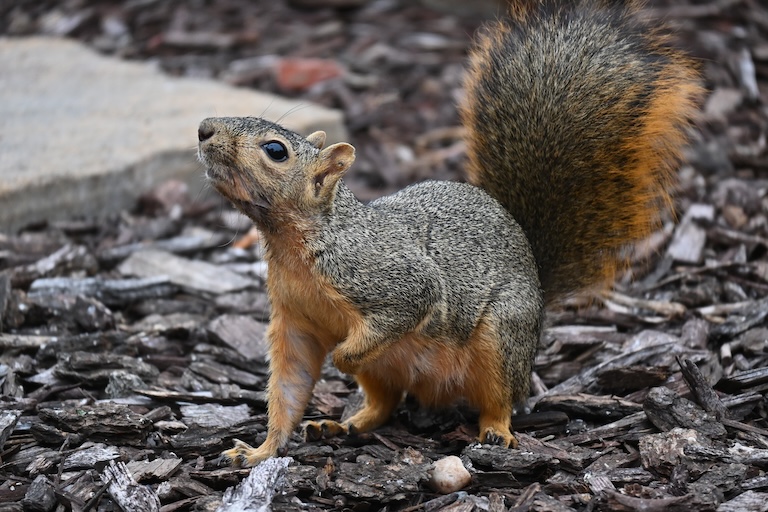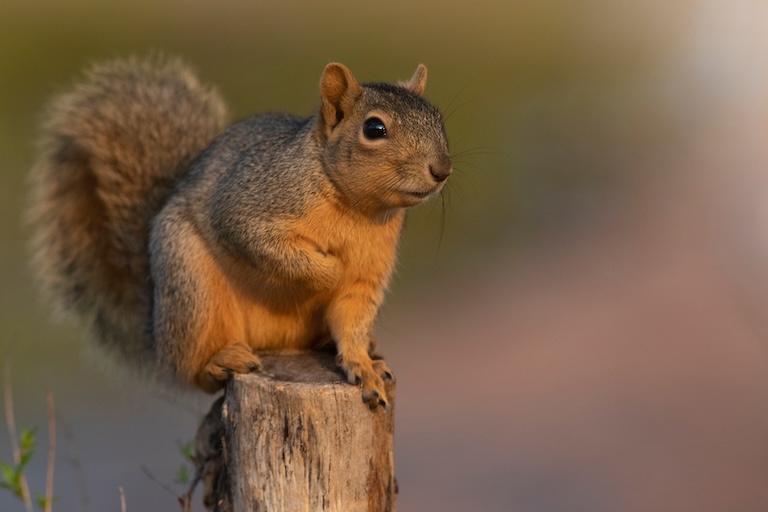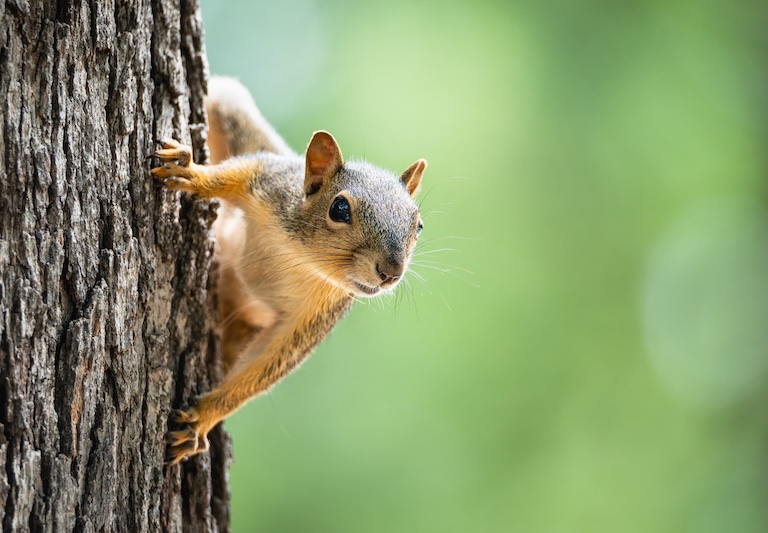Fox Squirrel Profile
As the most diverse order of mammals, rodents do it all. They have adjusted to almost every niche, even taking to the trees in the absence of their rodent-eating dinosaur predecessors.
Squirrels are unquestionably the tree specialists, though after a certain mass, they become less able to climb and begin to burrow instead.
The threshold for this transition isn’t known, but one guess is that it’s somewhere just a little chunkier than the mass of the fox squirrel: one of the largest tree squirrels in the world and one that’s still impressively agile.

Fox Squirrel Facts Overview
| Habitat: | Arboreal, preferably open, mature pine/oak habitat, ecotones between pine and other vegetation types |
| Location: | Eastern half of the US, South-Central Canada, South to Mexico |
| Lifespan: | 18 in captivity, 8 to 18 in the wild |
| Size: | 76 cm (30 in) long |
| Weight: | Up to 1.2 kg (2.5 b) |
| Colour: | Reddish brown |
| Diet: | Omnivorous: invertebrates, fruit, seeds, nuts, vegetation, eggs |
| Predators: | Mostly raptors, some snakes |
| Top Speed: | 19 km/h (12 mph) |
| No. of Species: | 1 |
| Conservation Status: | Least Concern |
Fox squirrels are the largest species of squirrel in North America and one of the heaviest in the world. Like similar species, they’re fast-moving, fast-living omnivores with a hankering for nuts, and they are very good at what they do.
This species is a significant contributor to North American woodlands, planting seeds, eating eggs, and providing meat for various predator species.
Interesting Fox Squirrel Facts
1. They’re big!
The fox squirrel, sometimes called Bryant’s fox squirrel, is a lot like the notorious Eastern grey squirrel, with whom its range overlaps. It’s also like the closely related American red squirrel, but an obvious difference is in the size of the beast.
This is one of the heaviest squirrels in trees, with a weight of up to 1.2 kg – and if you’re thinking, “Hmph, I weigh more than that!” well, perhaps you do, fatty, but you’re probably not a tree squirrel.
Tree squirrels typically top out at 1.8 kg, as seen in the Indian giant squirrel, after which they decide to become ground squirrels instead, and dig burrows.
The fox squirrel is therefore the biggest tree squirrel in North America.

2. They have acute senses
Fox squirrels see well in dim light, and their hearing and smell senses are tight, too. Scent is the main form of communication, but they will also chatter away, barking or screaming at one another about whatever it is squirrels have to talk about.
Mating involves familiar high-pitched whining noises and if sex isn’t on the menu, threats include twitchy tail motions to signify unease.
They also have whiskers on their forearms, as well as in all the usual places, which is another sensory advantage. 1
3. They’re nippy
It’s often difficult to get a handle on an animal’s top speed (see here, and here). There are just so few research papers entitled, “How fast can [insert animal] run?”, and while this is simply a product of scientific rigour, it leaves room for any wannabe animal blogger to just make up a value and palm it off as a fact.
But thankfully, a 1941 article called “How fast can a fox squirrel run?” means we don’t have to do that today. This speed was established by the tried and tested sampling method of chasing the animal with a car.
The answer is 19 km/h.
This readily available source hasn’t prevented the top Google result from being an unsourced claim of almost twice that, but that’s the internet for you. 2
4. They grow up fast
Young are born naked, cold, and confused, just like the rest of us. But unlike pathetic human offspring, they don’t need 45 years to get their shit together. By week five, they open their eyes (Ok, we have them beat on that landmark) and by week 8 they are fully weaned.
At 8 to 11 months, they’re sexually mature and ready to get going. From this point on, females can produce up to 2 litters of naked, cold, and confused kits per year, having to tolerate a copulation period of just thirty seconds from the target-oriented male.
5. They’re seed dispersers
While this species, like most tree squirrels, is omnivorous, different seasons bring differing levels of food availability. The strategy to compensate for this is to pick more than you need and bury the surplus in hidden stores all over someone’s lawn.
This is certainly a successful method, and the inherent level of forgetfulness in the squirrel is correlated with the success of the host plant, whose seeds it buries in the ground.
As such, there’s a symbiotic relationship, in which the plant produces seeds, the squirrel buries them, (taking a cut for the service), receiving more seed-producing plants in return. Seed dispersal is of course the world’s oldest profession, and has tied animals and plants together since seeds were invented.
6. They’re doing fine
Fox squirrels are doing fine in the sense that there are far more pressing concerns in other species, but they’re not immune to the habitat declines facing almost every other animal on the planet.
In Eastern US states, forest habitat is reducing, but interestingly, their populations are on the rise further down in the mid-west. Overall, the species isn’t considered to be of conservation concern yet, but they are in decline.
Still, for such a strong animal, it’s likely that as long as there are forests, there will be fox squirrels. 3
7. They’re banned from Europe
Like Monsanto in the European parliament, the fox squirrel’s potential for untold damage from its relentless seed greed has resulted in its banning across the European states.
This species may not be imported, bred, transported commercialized, or intentionally released into the environment in the whole of the European Union “Because their invasive character has been recognised and their introduction into the Union has an adverse impact on native species.”
We are still hoping for the exact same restrictions on anyone involved with Monsanto.

Fox Squirrel Fact-File Summary
Scientific Classification
| Kingdom: | Animalia |
| Phylum: | Chordata |
| Class: | Mammalia |
| Order: | Rodentia |
| Family: | Sciuridae |
| Genus: | Sciurus |
| Species: | niger |
Fact Sources & References
- Bridget Fahey, “Sciurus niger eastern fox squirrel”, Animal Diversity Web.
- Clarence Cottam “How Fast Can a Fox Squirrel Run?”, Oxford Academic.
- “Sciurus niger”, IUCN Red List.
